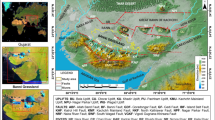Abstract
We examined 17 beaches in Tottori Prefecture to evaluate the current status of beach vegetation for conservation/rehabilitation purposes. We conducted a floristic survey and a beach vegetation status survey, and analyzed the beach environment using aerial photographs and a geographic information system. The health of the beach vegetation was evaluated by principal component analysis (PCA) of beach vegetation and environmental variables. PCA of beach vegetation variables, where axis 1 represented the scale of beach vegetation and axis 2 represented the quality of beach vegetation, resulted in four categories. PCA of beach environment variables, with axis 1 representing the synthetic component of grain/area/extension and axis 2 representing beach widths, also resulted in four categories. A beach vegetation list was determined from a floristic survey, and three conclusions were made based on this list. We first determined the priority of the beach plant species with regard to conservation. Based on their occurrence, the beach plants were divided into four types that were ordered with regard to their priority for beach plant conservation. We next focused on the occurrence of beach plants listed in the Red data book for Tottori Prefecture and reexamined the validity of the extinction risk category. Our conclusion was that this category needs to be updated. Finally, we compared the number of beach plant species of the survey site beaches with that of the Tottori Sand Dunes, where more natural conditions prevail. We found that only seven beaches equaled or surpassed the Tottori Sand Dunes in terms of the number of plant species. Based on these findings, we concluded that beaches other than the Tottori Sand Dunes are in need of conservation/rehabilitation.






Similar content being viewed by others
References
Ciccarelli D (2014) Mediterranean coastal sand dune vegetation: influence of natural and anthropogenic factors. Environ Manage 54:194–204
Ikoma Y (1962a) Sand dune plants in Tottori Sand Dune. Cultural Heritage Research Report in Tottori Prefecture, pp 71–74 (in Japanese)
Ikoma Y (1962b) Plants in Uradome coast, Tottori Prefecture. Cultural Heritage Research Report in Tottori Prefecture, pp 36–39 (in Japanese)
Ikoma Y (1963) Plants in Sanin coast. Research report to choose candidate site for national park of Sanin coast, pp 55–64 (in Japanese)
Kaneko S, Ohta Y, Shirakawa K, Inoue M, Tsutsumi M, Watanabe S, Sakuma T, Takahashi Y (2009) An attempt to evaluate the habitat type of endangered plant species in the Chugoku region, western Japan. Jpn J Conserv Ecol 14:119–123 (in Japanese with English summary)
Kiyosue T (1967) Plants in Uradome coast, Tottori Prefecture. Plant Nat 7:36–37 (in Japanese)
Landi M, Ricceri C, Angiolini C (2012) Evaluation of dune rehabilitation after 95 years by comparison of vegetation in disturbed and natural sites. J Coast Res 28:1130–1141
Ministry of the Environment, Japan (1994) According to the report of the Coastal Survey in the National Survey on the Natural Environment (in Japanese)
Nagamatsu D (2007) Vegetation and vegetation management in Tottori Prefecture. Landscape conservation research report in Tottori Sand Dune, pp 28–38 (in Japanese)
Nakanishi H, Fukumoto H (1991) Zonation of sand dune vegetation and depositional topography in the San-In District, western Honshu, Japan. Jpn J Ecol 41:225–235 (in Japanese with English summary)
Oka K, Yoshizaki S, Kobori H (2007) Effect of morphology and sand fence on zonation of coastal vegetation at the sandy shore of Shonan District, Kanagawa Prefecture. Papers Environ Inform Sci 21:87–92 (in Japanese with English summary)
Oka K, Yoshizaki S, Kobori H (2008) Factors for the zonation of coastal vegetation on the Enshu-nada coast, Shizuoka Prefecture. J Jpn Soc Reveg Technol Repr 34(1):57–62 (in Japanese with English summary)
Oshida K, Kamihogi A (2003) An examination of the factors that influence the present condition and species of coastal plants in the Osaka Bay area. J Jpn Inst Lands Architect 66(5):559–564 (in Japanese with English summary)
Oshida K, Kamihogi A (2004) Research on distribution characteristics of coastal plants in relation to zonation and their influential factors. J Jpn Inst Lands Architect 67(5):531–536 (in Japanese with English summary)
Ott T, van Aarde RJ (2014) Coastal dune topography as a determinant of abiotic conditions and biological community restoration in northern KwaZulu-Natal, South Africa. Landsc Ecol Eng 10:17–28
Sasaki Y, Morimoto Y (2004) The relationships between the coastal vegetation and environmental factors on natural coast of Seto inland sea. J Jpn Soc Reveg Technol 30(1):62–67 (in Japanese with English summary)
Sasaki Y, Shibata S, Morimoto Y (2006) The prediction and healthiness of plant species structure of coastal vegetation on semi-natural and artificial coasts of the Seto inland sea. J Jpn Soc Reveg Technol 31(3):364–372 (in Japanese with English summary)
Sawada Y, Tsuda S (2005) Thalassochory potential in 14 species of coastal plants in the warm temperate zone of Japan. Veg Sci 22:53–61 (in Japanese with English summary)
Sawada Y, Nakanishi H, Oshida K, Hattori T (2007) A check list of coastal plants in Japan. Hum Nat 17:85–101 (in Japanese with English summary)
The Research Group of Natural Environment Research in Tottori Prefecture (2002) Red data book (plants) in Tottori. Environmental Policy, Life and Environment Division in Tottori Prefecture (in Japanese)
The Research Group of Natural Environment Research in Tottori Prefecture (2012) Red data book (plants) in Tottori. Environmental Policy, Life and Environment Division in Tottori Prefecture (in Japanese)
Zamith LR, Scarano FR (2006) Restoration of a restinga sandy coastal plain in Brazil: survival and growth of planted woody species. Restor Ecol 14:87–94
Author information
Authors and Affiliations
Corresponding author
Rights and permissions
About this article
Cite this article
Nakata, Y., Hioki, Y. & Oguchi, T. Evaluation of beach vegetation for conservation/rehabilitation in Tottori Prefecture, Southwest Japan. Landscape Ecol Eng 14, 231–243 (2018). https://doi.org/10.1007/s11355-017-0344-8
Received:
Revised:
Accepted:
Published:
Issue Date:
DOI: https://doi.org/10.1007/s11355-017-0344-8




